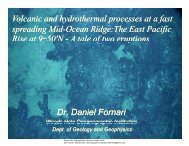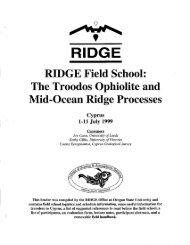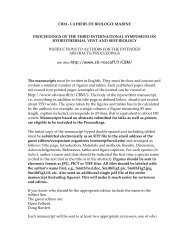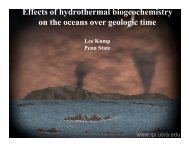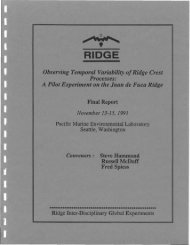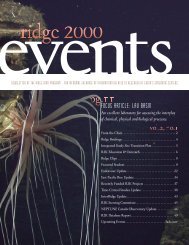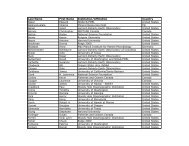You also want an ePaper? Increase the reach of your titles
YUMPU automatically turns print PDFs into web optimized ePapers that Google loves.
Related Studies<br />
In addition to these strategies which relate directly to the<br />
active ocean ridge system, there are two other areas of study<br />
which should provide important constraints which cannot be<br />
obtained in any other way. The first involves the study of<br />
ophiolites, which may be appropriate structural analogues for<br />
ocean crust and uppermost mantle, and are exposed in ways that<br />
never occur in the oceans, providing a unique three dimensional<br />
perspective. Detailed structural and geochemical investigations<br />
of these bodies can provide important constraints on the nature<br />
and scale of melt segregation processes in the uppermost<br />
mantle, on the size and internal dynamics of magma chambers, and<br />
on the critical interface between crustal magma bodies and<br />
circulating water systems.<br />
The second important objective is at least one deep crustal<br />
drill hole which extends all the way to the mantle. To date,<br />
the principal stratigraphic units in the ocean crust have been<br />
defined on the basis of characteristic velocities of transmitted<br />
seismic waves. Each of these layers is assumed to be composed<br />
of rock which has a seismic velocity similar to that of the<br />
layer, and analogous to the layers observed in ophiolites. But<br />
the bulk seismic properties of a rock may be very different from<br />
that of individual samples, since the bulk properties integrate<br />
the effect of cracks, veins and zones of alteration. Thus the<br />
assumption that ophiolites accurately represent the stratigraphy<br />
and composition of ocean crust has yet to be tested by actual<br />
observation and sampling of a deep section of ocean crust. Such<br />
a hole also is essential to provide "ground truth" against which<br />
we may test the correspondence between actual observed<br />
lithologic boundaries and the boundaries obtained by<br />
conventional seismic surveys in the vicinity of the hole.<br />
Continuous core sampling through layer 3 gabbro can also<br />
provide much mineralogical and geochemical information on the<br />
nature and rates of crystallization within a crustal magma<br />
chamber, and is the only way we can determine the bulk<br />
composition of the ocean crust. Also, the presumed connection<br />
between fractionated basalts I in layer 2) and crystallization<br />
processes in the chamber can be tested. Finally, if the hole<br />
does successfully penetrate the underlying mantle peridotite, we<br />
would for the first time have a coherent set of samples with<br />
which to trace the evolution of a melt from its origin as a<br />
mantle partial melt, through the deep crustal accretion zone, to<br />
its extrusion on the seafloor.<br />
1.<br />
out full<br />
imaging<br />
Data To Be Collected<br />
Morphology and Sampling. It will be necessary to carry<br />
coverage bathymetric mapping and side scan sonar<br />
at a wide range of resolutions, from the regional, to<br />
26






